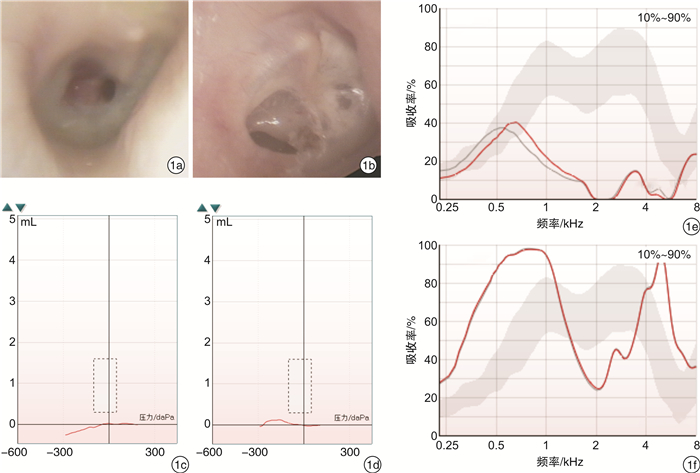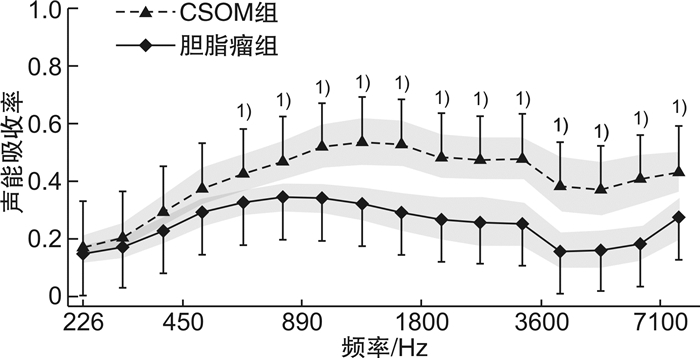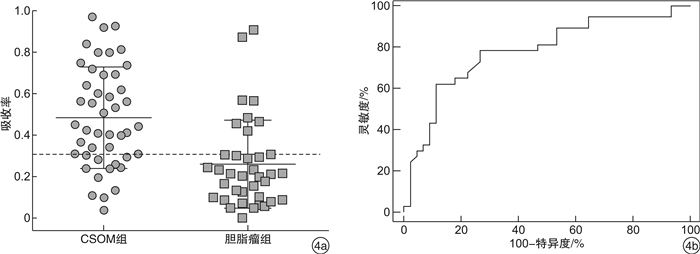Characteristics and differential diagnosis of middle ear cholesteatoma and chronic suppurative otitis media with wideband acoustic immittance
-
摘要: 目的 分析成人后天继发性中耳胆脂瘤和慢性化脓性中耳炎(CSOM)患者宽频声导抗的声能吸收率曲线,为二者的鉴别诊断提供依据。方法 以2020年9月—2021年12月徐州医科大学附属医院耳鼻咽喉科收治的38例后天继发性中耳胆脂瘤患者与40例CSOM患者为研究组,以30例(60耳)正常成人为对照组。选取16个频率点,以声能吸收率作为研究参数,比较三组在环境压下的宽频声能吸收率曲线特点,然后绘制研究组受试者工作特征曲线,计算曲线下面积及各频段下的诊断临界值与对应的灵敏度与特异度。结果 CSOM组在1100~5700 Hz、胆脂瘤组在560~5700 Hz间声能吸收率较对照组降低,部分频段差异有统计学意义;胆脂瘤组在226~7100 Hz频段吸收率低于CSOM组,在多个频段两者差异有统计学意义。研究组受试者工作特征曲线显示在560、710、890、4500 Hz频段曲线下面积>0.5,其余频段曲线下面积>0.7,P < 0.05;在2800 Hz频段曲线下面积最大,为0.78,此时的诊断临界值为0.31,对应的灵敏度为78.38%,特异度为73.33%。结论 宽频声导抗可作为成人后天继发性中耳胆脂瘤与CSOM鉴别诊断的辅助方法。Abstract: Objective Through analysis of the sound energy absorbance of wideband acoustic immittance to provide a basis for differential diagnosis of adult acquired secondary cholesteatoma of the middle ear and patients with chronic suppurative otitis media(CSOM).Methods 38 cases of cholesteatoma and 40 cases of CSOM admitted to the Department of Otolaryngology, Affiliated Hospital of Xuzhou Medical University from September 2020 to December 2021 were selected as the research group, and 30 cases (60 ears) of normal adults were selected as the control group. A total of 16 frequency points were selected, and the energy absorbance of wideband acoustic immittance was taken as the research parameter. The characteristics of energy absorbance under ambient pressure among the three are compared. Then the ROC in the cholesteatoma group was drawn, and by calculating the AUC, the Cut-off values and the corresponding sensitivity and specificity were found.Results The energy absorbance in CSOM group at 1100-5700 Hz and the cholesteatoma group at 560-5700 Hz was lower than that in the control group, and the difference in some frequency bands was statistically significant. The energy absorbance in the cholesteatoma group at 226-7100 Hz was lower than that in the CSOM group, and the difference between the two groups in many frequency points was statistically significant. The ROC in the research group was drawn and it was found that the AUC in the 560, 710, 890, and 4500 bands was > 0.5, and in the other bands was > 0.7(P < 0.05). The AUC in the 2800 Hz was the largest (0.78), the Cut-off value was 0.31, the corresponding sensitivity was 78.38%, specificity was 73.33%.Conclusion Wideband acoustic immittance can be used as an auxiliary method for the differential diagnosis of adult-acquired secondary cholesteatoma of the middle ear and chronic suppurative otitis media in adults.
-

-
表 1 耳别、年龄、性别、组别对各频率声能吸收率的影响
Ⅲ类平方和 自由度 均方 F P值 偏Eta平方 耳别 0.125 1 0.125 0.406 0.526 0.006 年龄 0.726 1 0.726 2.350 0.130 0.034 性别 0.376 1 0.376 1.216 0.274 0.018 组别 9.680 1 9.680 31.329 < 0.001 0.322 耳别*年龄 0.045 1 0.045 0.146 0.704 0.002 耳别*性别 0.129 1 0.129 0.418 0.520 0.006 耳别*组别 0.137 1 0.137 0.443 0.508 0.007 年龄*性别 0.024 1 0.024 0.079 0.780 0.001 年龄*组别 0.546 1 0.546 1.768 0.188 0.026 性别*组别 0.807 1 0.807 2.611 0.111 0.038 耳别*年龄*性别 0.386 1 0.386 1.250 0.268 0.019 耳别*年龄*组别 0.420 1 0.420 1.358 0.248 0.020 耳别*性别*组别 0.025 1 0.025 0.081 0.776 0.001 年龄*性别*组别 0.398 1 0.398 1.288 0.261 0.019 耳别*年龄*性别*组别 0.123 1 0.123 0.400 0.529 0.006 误差 20.392 66 0.309 注:耳别、年龄、性别、组别为主效应,*代表各交互效应。 表 2 研究组平均声能吸收率与P值
频率/Hz CSOM组 胆脂瘤组 P值 Power值 226 0.180±0.120 0.153±0.108 >0.05 0.309 280 0.216±0.144 0.177±0.120 >0.05 0.673 350 0.300±0.194 0.232±0.136 >0.05 0.556 450 0.385±0.222 0.294±0.134 >0.05 0.704 560 0.432±0.226 0.328±0.129 0.034 0.801 770 0.475±0.233 0.346±0.130 0.009 0.915 890 0.525±0.266 0.343±0.150 0.004 0.981 1100 0.542±0.280 0.324±0.159 0.002 0.995 1400 0.537±0.274 0.295±0.188 0.000 0.998 1800 0.488±0.262 0.271±0.214 0.001 0.990 2200 0.482±0.245 0.263±0.250 < 0.001 0.987 2800 0.485±0.243 0.256±0.213 < 0.001 0.997 3600 0.391±0.319 0.161±0.169 0.005 0.989 4500 0.376±0.313 0.168±0.177 0.005 0.975 5700 0.412±0.290 0.185±0.168 0.001 0.995 7100 0.439±0.232 0.277±0.208 0.003 0.943 表 3 各频率诊断的灵敏度与特异度
频率/Hz AUC P值 临界值 灵敏度/% 特异度/% 560 0.65 0.02 0.38 70.27 55.56 710 0.68 < 0.01 0.33 75.68 62.22 890 0.70 < 0.01 0.51 94.59 48.89 1100 0.72 < 0.01 0.48 86.49 62.22 1400 0.76 < 0.01 0.47 83.78 62.22 1800 0.73 < 0.01 0.38 78.38 66.67 2200 0.75 < 0.01 0.25 66.16 82.22 2800 0.78 < 0.01 0.31 78.38 73.33 3600 0.70 < 0.01 0.37 98.19 51.11 4500 0.70 < 0.01 0.42 86.19 46.67 5700 0.72 < 0.01 0.43 91.89 53.33 7100 0.71 < 0.01 0.33 72.97 62.22 -
[1] Yung M, 刘志标. 欧洲耳科与神经耳科学会和日本耳科学会关于中耳胆脂瘤的定义、分类和分期的联合共识[J]. 听力学及言语疾病杂志, 2017, 25(6): 666-667. doi: 10.3969/j.issn.1006-7299.2017.06.028
[2] 孙建军, 刘阳, 中耳炎临床分类和手术分型指南(2012)解读[J]. 中华耳鼻咽喉头颈外科杂志, 2013, 48(1): 6-10. doi: 10.3760/cma.j.issn.1673-0860.2013.01.004
[3] 黄选兆, 汪吉宝, 孔维佳. 实用耳鼻咽喉头颈外科学[M]. 2版. 北京: 人民卫生出版社, 2017: 862-863.
[4] Keefe DH, Sanford CA, Ellison JC, et al. Wideband aural acoustic absorbance predicts conductive hearing loss in children[J]. Int J Audiol, 2012, 51(12): 880-891. doi: 10.3109/14992027.2012.721936
[5] Ṡliwa L, Kochanek K, Jedrzejczak WW, et al. Measurement of Wideband Absorbance as a Test for Otosclerosis[J]. J Clin Med, 2020, 9(6): 1908. doi: 10.3390/jcm9061908
[6] 陈露静, 兰兰, 黄鑫, 等. 耳硬化症和中耳畸形患者的宽频声导抗研究[J]. 中华耳科学杂志, 2020, 18(1): 57-62. doi: 10.3969/j.issn.1672-2922.2020.01.010
[7] 刘洁, 蒋雯, 林欢, 等. 梅尼埃病患者宽频声导抗测试特点初步研究[J]. 临床耳鼻咽喉头颈外科杂志, 2021, 35(12): 1068-1072. https://www.cnki.com.cn/Article/CJFDTOTAL-LCEH202112003.htm
[8] Miehe J, Mogensen S, Lyhne N, et al. Wideband tympanometry as a diagnostic tool for Meniere's disease: a retrospective case-control study[J]. Eur Arch Otorhinolaryngol, 2022, 279(4): 1831-1841. doi: 10.1007/s00405-021-06882-7
[9] 孙秀珍, 李生, 刘迎曦, 人耳鼓膜穿孔对中耳传声影响的数值模拟[J]. 计算力学学报, 2010, 27(6): 1102-1106. https://www.cnki.com.cn/Article/CJFDTOTAL-JSJG201006024.htm
[10] 辛文君, 张晓彤, 崔珑, 等. 外伤性鼓膜穿孔临床观察对比研究[J]. 临床耳鼻咽喉头颈外科杂志, 2015, 29(18): 1610-1614. https://www.cnki.com.cn/Article/CJFDTOTAL-LCEH201518006.htm
[11] Schairer KS, Putterman DB, Keefe DH, et al. Automated Adaptive Wideband Acoustic Reflex Threshold Estimation in Normal-hearing Adults[J]. Ear Hear, 2021, 43(2): 370-378.
[12] Downing C, Kei J, Driscoll C, et al. Wideband Tympanometry Findings in School-aged Children: Effects of Age, Gender, Ear Laterality, and Ethnicity[J]. Ear Hear, 2021.
[13] Aithal S, Kei J, Aithal V, et al. Normative Study of Wideband Acoustic Immittance Measures in Newborn Infants[J]. J Speech Lang Hear Res, 2017, 60(5): 1417-1426. doi: 10.1044/2016_JSLHR-H-16-0237
[14] 傅新星, 刘博, 林萌, 等. 听力正常青年人宽频声导抗研究[J]. 临床耳鼻咽喉头颈外科杂志, 2017, 31(18): 1402-1407. https://www.cnki.com.cn/Article/CJFDTOTAL-LCEH201718009.htm
[15] 邢宇轩, 蒋雯, 仝悦, 等. 听力正常青年人宽频声导抗能量吸收率的初步研究[J]. 山东大学耳鼻喉眼学报, 2020, 34(1): 38-41. https://www.cnki.com.cn/Article/CJFDTOTAL-SDYU202001009.htm
[16] Mazlan R, Kei J, Ya CL, et al. Age and Gender Effects on Wideband Absorbance in Adults With Normal Outer and Middle Ear Function[J]. J Speech Lang Hear Res, 2015, 58(4): 1377-1386. doi: 10.1044/2015_JSLHR-H-14-0199
[17] Shahnaz N, Feeney MP, Schairer KS. Wideband acoustic immittance normative data: ethnicity, gender, aging, and instrumentation[J]. Ear Hear, 2013, 34 Suppl 1: 27S-35S. doi: 10.1093/eurheartj/eht307.27
[18] Rosowski JJ, Stenfelt S, Lilly D. An overview of wideband immittance measurements techniques and terminology: you say absorbance, I say reflectance[J]. Ear Hear, 2013, 34 Suppl 1: 9S-16S.
[19] Park HW, Ahn J, Kang MW, et al. Postoperative change in wideband absorbance after tympanoplasty in chronic suppurative otitis media[J]. Auris Nasus Larynx, 2020, 47(2): 215-219. doi: 10.1016/j.anl.2019.08.010
[20] 黄孟捷, 郑芸, 王恺. 正常成人宽频声导抗能量反射的初步研究[J]. 听力学及言语疾病杂志, 2010, 18(5): 433-436. doi: 10.3969/j.issn.1006-7299.2010.05.008
[21] Nakajima HH, Pisano DV, Roosli C, et al. Comparison of ear-canal reflectance and umbo velocity in patients with conductive hearing loss: a preliminary study[J]. Ear Hear, 2012, 33(1): 35-43. doi: 10.1097/AUD.0b013e31822ccba0
[22] Voss SE, Merchant GR, Horton NJ. Effects of middle-ear disorders on power reflectance measured in cadaveric ear canals[J]. Ear Hear, 2012, 33(2): 195-208. doi: 10.1097/AUD.0b013e31823235b5
[23] 潘骏良, 杨军, 宽频声导抗在分泌性中耳炎诊断中的临床应用价值[J]. 临床耳鼻咽喉头颈外科杂志, 2018, 32(17): 1309-1315. https://www.cnki.com.cn/Article/CJFDTOTAL-LCEH201817005.htm
[24] Kim SY, Han JJ, Oh SH, et al. Differentiating among conductive hearing loss conditions with wideband tympanometry[J]. Auris Nasus Larynx, 2019, 46(1): 43-49. doi: 10.1016/j.anl.2018.05.013
[25] Voss SE, Rosowski JJ, Merchant SN, et al. How do tympanic-membrane perforations affect human middle-ear sound transmission?[J]. Acta Otolaryngol, 2001, 121(2): 169-173. doi: 10.1080/000164801300043343
-





 下载:
下载:


